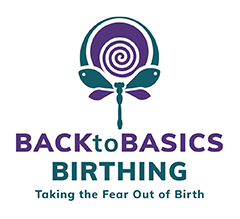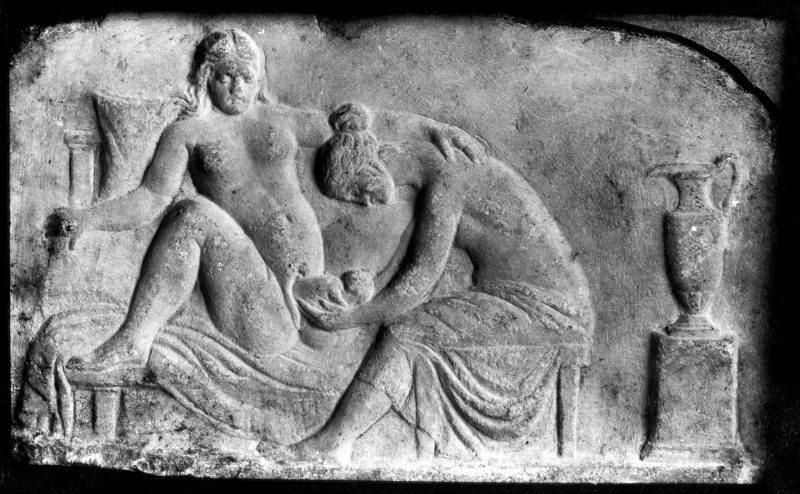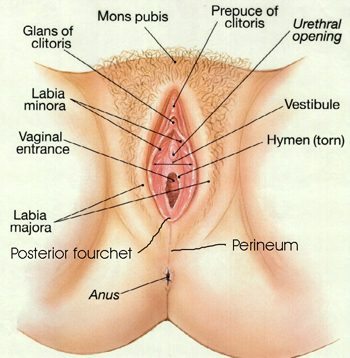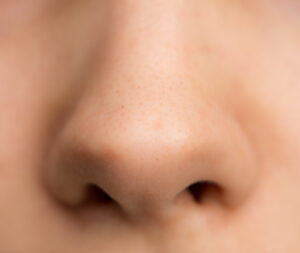Contact Vicki
If you have any questions or would just like more information please don't hesitate to get in touch by clicking the button below and filling out the contact form.
Contact Vicki

The perineum is the area between the vagina and anus, made up of skin, tissue and muscle and stretches incredibly as the head emerges. Many women become fearful about the perineum tearing or needing an episiotomy and wonder how their baby is going to fit through their vagina.
An episiotomy is where the Obstetrician or midwife will make an incision across the medio-lateral area of the perineum to make a larger opening for the baby to fit through so that you do not tear.
Research has shown that episiotomies cause more pain, trauma, blood loss and takes longer to heal compared to a natural tear and unless there is a medical need to do an episiotomy then there were no benefits and more harm associated with it.
CLICK HERE TO READ ABOUT THE RESEARCH
In 2006, Beckmann and Garrett combined the results from four randomized, controlled trials that enrolled 2,497 pregnant women. Three of these studies involved only women without a previous vaginal birth (mostly first-time mums). One study enrolled women with and without a previous vaginal birth. All four of the studies were of very good quality.
Beckmann and Garrett found that women who were randomly assigned to do perineal massage had a 10% decrease in the risk of tears that required stitches (aka “perineal trauma”), and a 16% decrease in the risk of episiotomy—but these findings were only true for first-time mums.
CLICK HERE TO READ MORE ABOUT THESE TRIALS

The good news is that you are less likely to experience tearing or episiotomy if you are breathing deeply and allowing your body to feel calm and relaxed without tension, relaxing your pelvic floor and going with your own urge to push rather than holding your breathe and being told when to push (purple pushing).
The breathing technique is very easy to master.
Just remember to breathe in through your nose and then a long strong breath out through your nose (or your mouth like a fire breathing dragon if you have a cold).
When you breathe out allow yourself to breathe out until you have no more air left.
Feel your breath and your muscles working to push baby down – you are still pushing but using your breath as well, rather than holding your breath – it is like you are trying to squeeze the baby out.
Then start again, long slow breath in as far as you can go, then a long strong breath out again.
A good way to feel this is when you blow your nose into a tissue that is what you should be feeling in your pelvic / vaginal area.
So why nasal breathing?
Breathing from the diaphragm increases the oxygen flow down to the muscles of the uterus and to the baby and helps a woman to conserve energy. Research using electroencephalography (EEG) shows that diaphragmatic breathing alters a person’s brainwaves in a positive way, increases relaxation, decreases stress and blood pressure, and increases oxygen levels.
A marathon runner needs to ensure that they are getting oxygen to their muscles so that they don’t seize up or become tense. This is the same necessity for a labouring woman – she is running a marathon too – a birth marathon – and so she needs to ensure that she is breathing efficiently.
As the nose opens up, so does your lungs.
Breathing expert and former world record holder Stig Severinson (who can hold his breath underwater for 22 minutes) breaks down the importance of breathing and how it affects the body, particularly during pregnancy and of course labour and birth.
“The nose is for breathing; the mouth is for eating” and this makes a big difference to relaxation through the whole body and of course your baby.
Stig talks about how nasal breathing ensures better blood flow and lung volumes and activates the vagus nerve that controls the parasympathetic system, which sends more oxygen to the brain and organs. This is instrumental in decreasing alertness, balancing your blood pressure and heart rate, and helping you to feel calm and relaxed.
The nasal passage also filters airborne particles preventing harmful bacteria from entering the respiratory system. Our nasal passage warms and humidifies inhaled air before it goes through the respiratory tract so that it doesn’t damage the lungs, which could irritate the lungs, causing wheezing, coughing and shortness of breath.
Nasal breathing also regulates our body’s oxygen (O2) and carbon dioxide levels (CO2) – we need a balance of both, and nasal breathing helps to keep homeostasis. When we mouth breathe, we expel too much carbon dioxide, and this can lead to hyperventilation, lightheadedness, and less efficient body function.
Nasal breathing creates nitric oxide, which is a vasodilator, which helps expand blood vessels to improve blood circulation, lowers blood pressure, boosts immune system, brain function and energy.
Mouth breathing also increases a dry mouth, leading to dehydration, sore throat and nasal congestion.
Interestingly, when we are born, we don’t breathe through the mouth for the first few months until the respiratory system is fully formed.
It is up to the woman to find the best and most comfortable way to breathe but start off with breathing in through the nose and breathing out through the nose. Some women find it difficult to breathe out through the nose due to congestion or sinus problems, so again, just find what feels right for you. If you have a blocked nose, then it makes sense to adjust to suit so you can breathe in through the nose and then out through the mouth.
Or if that doesn’t feel comfortable then just go with whatever feels right for you, as long as you are breathing through your contractions. Don’t get stuck on trying to nasal breathe when it is too difficult.
That is the key!

Another important thing to remember is that the perineum stretches because of the hormone relaxin already in the body and becomes incredibly thin, soft and stretchy like a rubber band.
As the perineum stretches, the birthing woman may feel a burning type of sensation.
This is similar to what you would feel if you stretched the corner of your mouth with your fingers – the tissue of the corner of the mouth is similar to that of the perineum.
Just try this now – stretch the corner of your mouth until you feel it stretching and “burning” and that is what you will experience during childbirth.
The best positions to birth in to reduce the risk of tearing are:
Midwives may also be able to reduce the risk of tearing by using warm packs on the perineum when the head is coming through and this also helps to relieve the burning sensation felt with the stretching.
Hannah Dahlen is the Professor of Midwifery at the University of Western Sydney. She has released a study relating to this which highlighted the effectiveness of reducing tearing while holding a warm compress against the perineum. Here is a video of Hannah sharing how to do this technique for health care providers or maybe even birth partners:
If your body is given the opportunity to birth naturally without being induced or sped up, then your perineum will stretch gradually, slowly and gently the way it has been designed to do and is less likely to experience any trauma.
It is also important to know that a natural tear can heal a lot better and faster due to the fibres connecting, rather than when they are subjected to a straight cut during an episiotomy. The healing time from an episiotomy is longer and not as strong because it is a straight edge that doesn’t “mesh” together strongly.
A very good article relating to protecting the perineum by midwife, researcher and lecturer Rachel Reed has some very good references.
There is a difference between perineum “stretching” and perineum “massage” and my suggestion is to use the technique that works best for you.
Most women are encouraged to do perineum “stretching” by their midwives, and this is where you insert your thumbs into your vagina and push down and outwards to stretch the perineum. Obviously, what works for one may be useless for another so you can decide if this is something you wish to do or feel comfortable with. From hearing other women’s experiences, I have found that some women just don’t feel comfortable doing this or they can’t even reach.
It is also worth considering that because women don’t really know what they are doing they may cause more damage or weaken the perineum tissue, creating microscopic tearing, which can increase the risk of tearing during birth. Also keep in mind that your body will release the hormone relaxin to help soften and stretch the perineum before and during labour, however if you are stretching manually before this occurs, again you might just be causing more damage and weakness.
Here is a really informative video by Sophie Kirkham who is a hypnobirthing practitioner in the UK, and it is probably one of the better videos I’ve seen on perineum “stretching” although again she does use the term “massaging” but it is about “stretching” the perineum.
A better idea would be to soften the external area between the anus and the vagina by “massaging” gently with some coconut oil.
Wash your hands and put a little coconut oil on your fingertips.
Sit down on a chair with your legs open and feet resting on another chair.
Gently just massage the external area between the anus and the vagina (the perineum) at least twice a day from 34 weeks.
There is no evidence to support the many stretching devices on the market that can be very expensive and may also be detrimental to the perineum tissue. These devices tend to force the area to be stretched when the body is not ready, and the right hormones are not present such as relaxin to help the tissue stretch, therefore again you may be causing more damage to the area, than helping it.
Notice the perineum stretching gently as the baby’s head emerges. This image was taken by professional photographer, Angela Gallo, (which I have paid for to use in this blog). Notice the midwife is supporting the perineum with a warm cloth and she is not pushing down or interfering with the process, just supporting the perineum in a gentle way.
My suggestion to you is to relax your body, release tension in the muscles, focus on your deep breathing, focus on your mindset and say, “I CAN DO THIS AND I AM DOING THIS” and allow your body to do what it has been perfectly designed to do.
If you have any questions or would just like more information please don't hesitate to get in touch by clicking the button below and filling out the contact form.
Contact Vicki